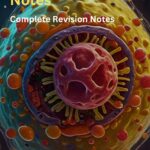 IB Biology Notes
IB Biology Notes
IB Biology, part of the International Baccalaureate (IB) Diploma Program, is a rigorous two-year course designed for high school students who want a deeper understanding of biology at a pre-college level. Offered at both the Standard Level (SL) and Higher Level (HL), the course aims to develop students' scientific knowledge, research skills, and critical thinking.
Key Components of IB Biology:
- Core Topics: All students (SL and HL) study foundational biology topics, which typically include:
- Cell biology
- Molecular biology
- Genetics
- Ecology
- Evolution and biodiversity
- Human physiology
- Additional Topics (HL): Higher Level students cover additional, more advanced material in each topic area and study some extended topics such as:
- Nucleic acids
- Metabolism
- Plant biology
- Genetics and evolution
- Animal physiology
- Practical Work and Lab Skills: IB Biology emphasizes hands-on experiments and practical lab work, which is essential for understanding scientific concepts in a real-world context. Labs help students develop practical skills, like precise measurements, experimental design, and data analysis.
- Internal Assessment (IA): A unique research project that students design, conduct, and present as part of their final assessment. It accounts for 20% of the overall grade and assesses students' ability to perform and communicate scientific research.
- Exam Structure:
- Paper 1: Multiple-choice questions
- Paper 2: Short-answer and extended-response questions
- Paper 3: Data analysis, lab-based questions, and optional topics at HL
IB Biology is highly respected by colleges for its comprehensive curriculum, promoting independent thinking and problem-solving skills ideal for students interested in pursuing biology, medicine, or related fields.
CORE:
Topic 1: Cell Biology
Topic 2: Molecular Biology
Topic 3: Genetics
Topic 4: Ecology
Topic 5: Evolution and Biodiversity
Topic 6: Human Physiology
ADDITIONAL HIGHER LEVEL:
- Topic 7: Nucleic Acids
- Topic 8: Metabolism, Cell Respiration & Photosynthesis
- Topic 9: Plant Biology
- Topic 10: Genetics and Evolution
- Topic 11: Animal Physiology
13 units
·
731 lessons
|
Last updated: November 22, 2024
|
Please login to save the post
Notes
Flashcards
Questions
MCQ Quiz
Exam Study Notes
13 units
·
731 lessons
15 topics
9 topics
10 topics
8 topics
5 topics
8 topics
11 topics
8 topics
13 topics
13 topics
12 topics
8 topics
18 topics
8 topics
12 topics
11 topics
17 topics
14 topics
22 topics
16 topics
19 topics
10 topics
15 topics
12 topics
11 topics
11 topics
14 topics
10 topics
11 topics
18 topics
13 topics
11 topics
15 topics
17 topics
14 topics
11 topics
15 topics
9 topics
15 topics
17 topics
11 topics
9 topics
9 topics
9 topics
10 topics
12 topics
9 topics
17 topics
14 topics
15 topics
13 topics
6 topics
5 topics
8 topics
17 topics
12 topics
11 topics
14 topics
10 topics
14 topics
Flashcards
Will be Added soon.....
MCQ Quiz
0 found this helpful out of 0 votes
Helpful: 0%
Helpful: 0%
Was this page helpful?
